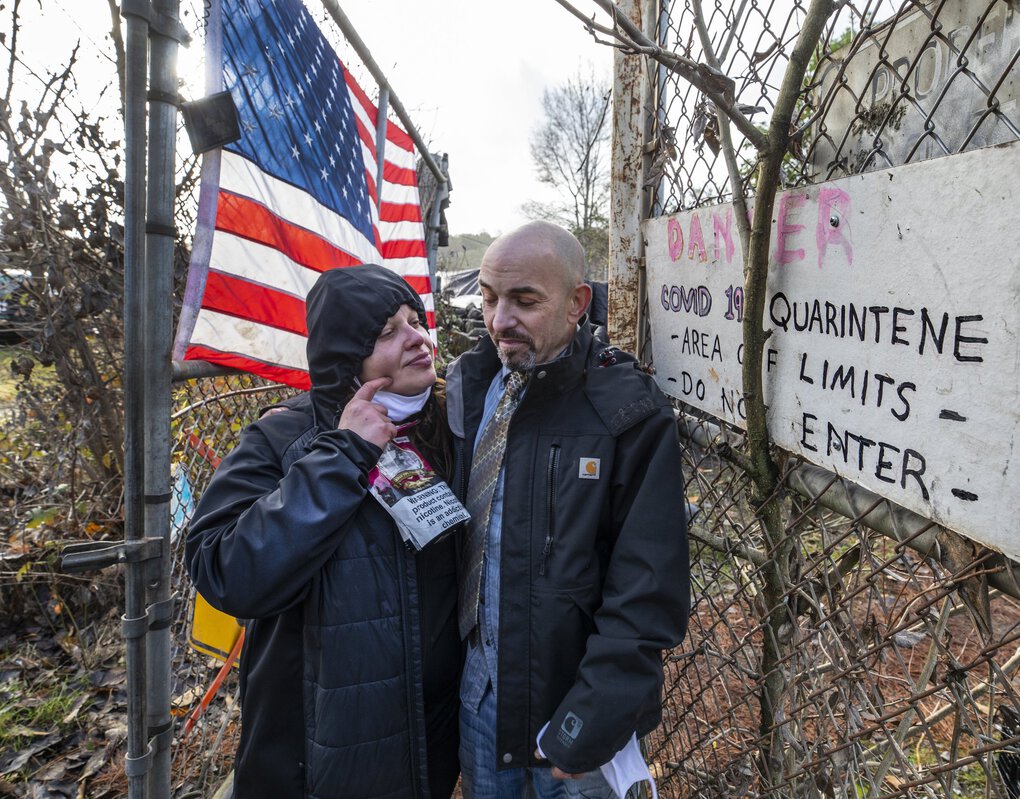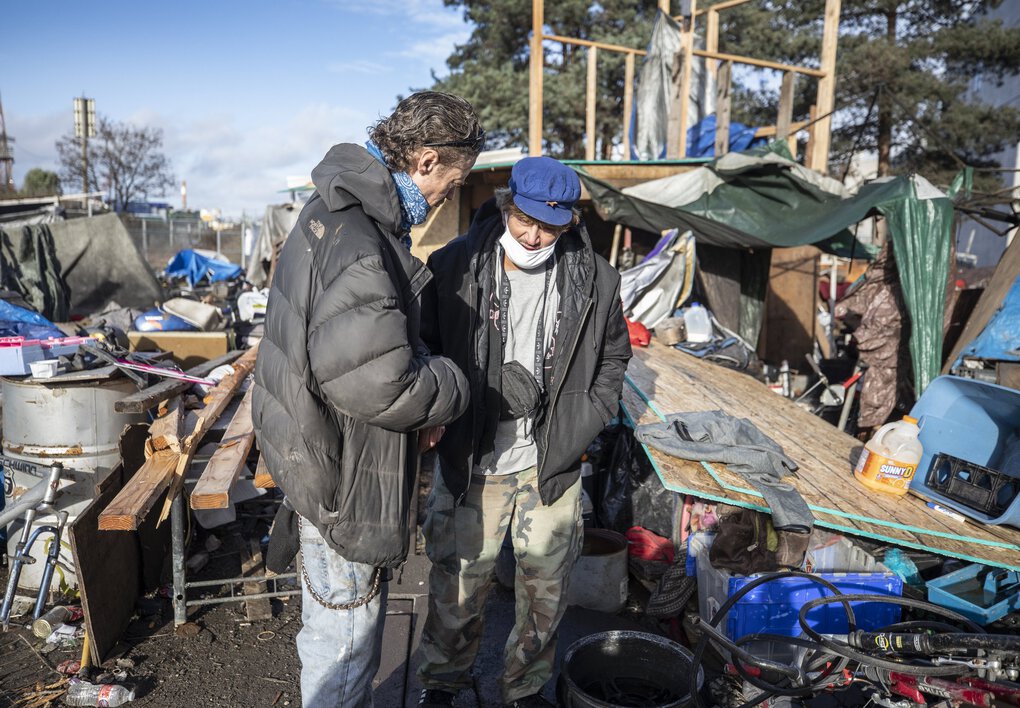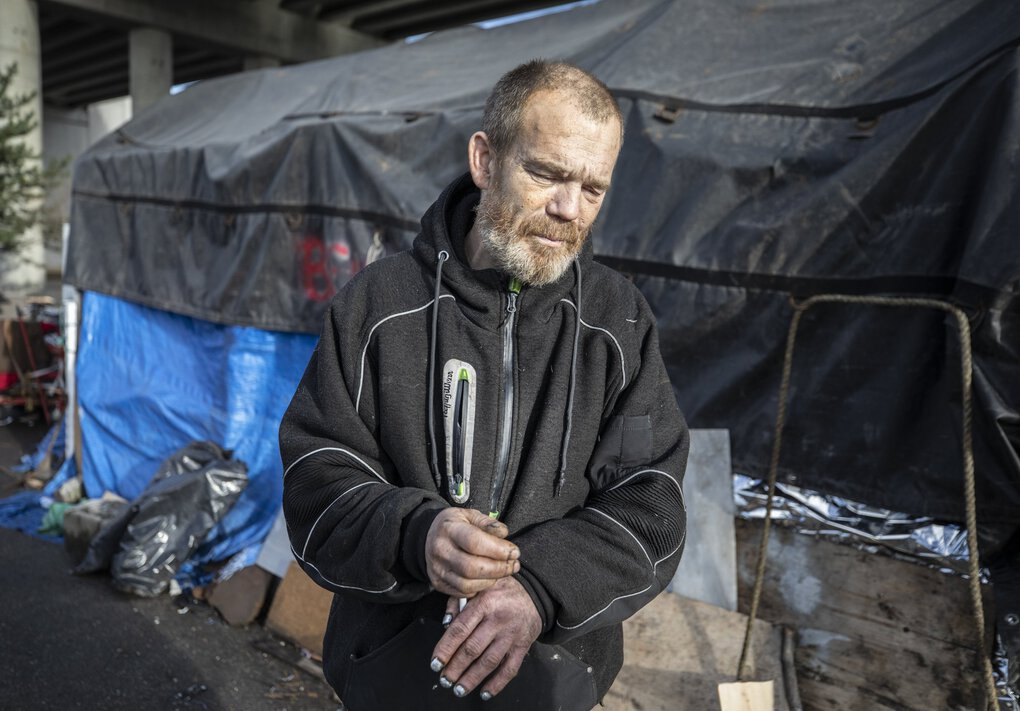By Scott Greenstone Dec. 26, 2020 at 6:00 am Updated Dec. 29, 2020 at 10:08 am

Tish Roth and her husband Imra VanWolvelaere stand at the entrance to a homeless encampment in Seattle where people tested positive and a warning sign was put up by those living in the area. (Steve Ringman / The Seattle Times)
When more than a dozen people tested positive for the coronavirus at a homeless camp in South Park in July, despair set in.
“How long do I have to live?” Kenny Palazzo asked his case manager, Dawn Whitson, when he tested positive. Whitson, who works for REACH, the outreach arm of a local nonprofit drug treatment provider, told him he would most likely live, but he needed to isolate in a hotel and quarantine.

But Palazzo didn’t, and neither did almost everyone else who tested positive in this camp. They worried their belongings would be stolen while they were gone. Rumors swirled about homeless people being shipped off to FEMA camps or locked up.
Palazzo just didn’t want to die alone.
“If I was going to die, I was going to die on my own terms,” Palazzo said recently, recounting that time.
These hurdles foreshadow the massive barriers King County will face in 2021 trying to vaccinate thousands of homeless people in King County — particularly people living outside. So far, it is unclear where they will fall in vaccine priority.
People staying in homeless shelters are in the second tier of prioritization, along with other settings where people share space like nursing homes and correctional facilities. But the U.S. Centers for Disease Control and Prevention hasn’t yet offered much guidance on outdoor encampments. And in King County at last count, people living outside made up nearly half the homeless population at more than 5,500 — though that number has likely risen since the pandemic.
When it’s their turn, vaccinating the population of people living outdoors will be a huge logistical feat: Health officials must figure out how to distribute it to a geographically disparate group of people who are often impossible to find and tend to distrust institutional medicine — and then likely do it all again with a second dose.
On top of that, Seattle and King County’s public health department, which will be leading the charge, is staring down a federal funding cliff at the end of the year if Congress doesn’t extend emergency relief dollars, which may mean the agency has to lay off the staff who would distribute the vaccine to homeless and low-income people, King County’s public health officer said in a news conference earlier this month.
“We don’t have enough to sustain our work or build our work,” said TJ Cosgrove, who leads the public health department’s response to homelessness amid COVID-19. “This is ‘perfect storm’ stuff.”
As of yet, there have been few large-scale documented outbreaks outdoors: At the start of the pandemic, health workers feared a possible decimation of the homeless population, based on factors like a 50-year-old average life expectancy and high rates of preventable disease — but that fear hasn’t materialized in Seattle.
Experts say it’s something of a mystery why outbreaks never arose in the Seattle area’s homeless encampments, which have grown during the pandemic as shelters shrunk.
“We have been looking actively for it — as intensively as I think anyone can,” said Dr. Helen Chu, an infectious disease doctor who recently published a study on COVID-19 spread in Seattle-area shelters. “And we haven’t found it.”
Why hasn’t COVID-19 spread in homeless camps?
In July, in the South Park camp,Whitson and nurses from nonprofit health care provider Neighborcare Health told people to isolate in their tents and wear masks, but not everyone did, Whitson said. When the nearby food bank shut down with its own COVID-19 case, Whitson and Neighborcare worked frantically to deliver dozens of pizzas so people didn’t leave the camp looking for food.
Nevertheless, the outreach staff braced themselves for what they’d been expecting since the beginning of the pandemic.
“We really thought that was going to open the flood gates,” Whitson said, “that it would spread like wildfire. People know each other, they spend time with each other in tents and shelters. All of us expected this to be, like, the beginning.”
But the wave never came. The 15 cases associated with that site are the only ones that have been tracked outside to this day.
The camp in South Park where coronavirus emerged is a tight-knit group of people: Dean Williamson grew up with Kenny Palazzo in Renton and is his next-door neighbor today, staying in a tent less than 30 feet away.
“We shared cigarettes, we’re around each other every day,” Williamson said.
Williamson’s first coronavirus test was inconclusive and his second was negative, but he went to a publicly funded motel room in Kent anyway to stay away from the other campers who did test positive. When he came back, COVID-19 hadn’t spread to the other people in the camp or outside, and no one had had symptoms. He grew suspicious.

“This deadly, deadly virus that, for some reason, doesn’t affect homeless people?” Williamson said. “A bunch of political [expletive] is going on.”
There are many theories floating around about why only 15 COVID-19 cases have been found in outdoor communities in King County. The most obvious one is that the residents are outside all the time, where the virus doesn’t spread as quickly. They rarely gather in large groups, so there’s a low chance of a “super-spreader” event, according to Dr. Stephen Hwang, a Toronto doctor currently studying the spread of COVID-19 in homeless populations there.
“Being in a tent with four friends is probably lower risk than being in a shelter with a hundred other people,” Hwang said. “It’s really a numbers game.”
It’s also possible the virus already made its way through the population but undetected: 80% of the positive cases in King County shelters have been asymptomatic, according to Chu, the Seattle researcher. She thinks that’s because many of the old and particularly vulnerable homeless people were moved to hotels. But that percentage still strikes her as surprisingly high.
“Homeless people tend to have a lot more problems that would make them have symptomatic infection,” Chu said.
And there could be many more cases official counts miss. Only about 600 tests have been conducted in outdoor settings, according to Public Health – Seattle & King County, a fraction of the more than 14,000 tests in shelters.
The only reason it was caught at the South Park camp, Whitson and an outreach nurse said, was because a camper went to a local hospital for cancer treatment and tested positive there.
Vaccine skepticism
After his friends made it through COVID-19 apparently unscathed, Williamson no longer wears a mask except when bus drivers make him, and he says he won’t take the vaccine.
“If I got a bug and died, I could accept that. Really,” Williamson said. “I’ve had a good life.”
Many homeless people — who are often treated poorly in hospitals or by medical professionals, they say — are skeptical of doctors and prescribed treatments. About 45% of homeless people surveyed by the Seattle Flu Study got flu vaccinations so far this year.
Cosgrove, with King County’s public health department, pointed to the county’s success persuading thousands of homeless people to get vaccinated in the past three years. In an interview, he was more optimistic about being able to retain the staff that would distribute the vaccine to people living outside.
With his workforce intact, he hopes to replicate the agency’s ability to reach people during the last few years’ hepatitis A outbreak in the homeless population. So far, Public Health has vaccinated more than 5,500 people and hepatitis A diagnoses have plummeted.
Jody Rauch, a public health nurse who coordinates homelessness efforts with the Healthcare for the Homeless Network, said it’s because outreach workers keep coming back to the same places and building relationships over time.
“Sometimes it’s the second time — sometimes it’s the fifth time,” Rauch said.
Those relationships could be the key for this outbreak as well. At South Park, while Palazzo might be on the fence about a vaccine personally, he trusts Whitson, his outreach worker.
“If they came out with a good vaccine … I would take it,” Palazzo said. “I’d call Dawn and ask her if it was OK.”
